Lord of the Mango Tree
Kanchipuram is an old city and in its time was a grand city. This 2000 year old ramble of temples and dynasties, say some schools of thought, was the home of Bodhidharma before his travels to China. Down the dusty streets and under the mango trees of the town the father of Chan and Zen Buddhism once meditated. It was here that, if he existed at all, he came to the realization of mind-only and the rejection of devotional rituals that would change the way Buddhism was seen forever after.
Not long after Bodhidharma's time the Buddhists rulers fell to the great Hindu temple builders of the Pallava dynasty, the same kings who built the monuments of Mamallapuram. What they started with the shore temple they finished here, bringing temple architecture to a zenith that would forever define the Dravidian style of temples. The Cholas would add refinements, certainly, but it was here that the glory of the soaring gopurams and reflective tanks reached their finalized form – a form that lasts to this day, almost 1200 years later.
It was in these great temples that the Brahmins received, recalled, or rehallowed the great center of Kanchipuram: the mango tree under which Lord Shiva was married. This spot is now one of the holiest in all Hinduism, a spot where the divine touched the world and a god married a goddess, sealed forever in an act that guaranteed the continuation of the universe. Even to this day you can see the mango tree where they were married, a marvel of nature that gives mangoes of four different flavors, one for each of the Vedas.
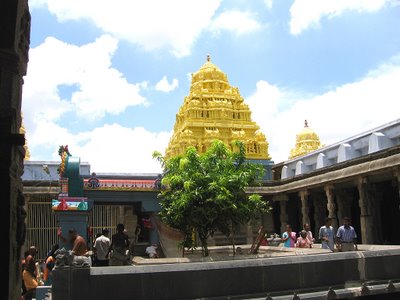
Once upon a time all of the great Tamil dynasties built their temples here, trying to outdo the Pallavas. The Cholas and the Pandyas, in turns, would build temples to rival that of the Mango Tree. They built to Shiva and to Vishnu, making Kanchi one of the few places in India equally holy to the two great gods, a place where rival sects both come for their holiest of pilgrimages. It was during this time that the great traveler Hsuan Tsang cam to Kanchi and commented on how pious and brave where its people, how great its universities and centers of learning. The temple city was even spoken of with love by Kalidasa, the Shakespeare of India, as the Jasmine City, sweetest of all cities of India.
Even into modern times Kanchipuram was vastly important. Robert Clive, in his drive to dominate India, appeased local sensibilities by giving a fabulous necklace to the great Vishnu temple. To this day it is said that the god is dressed in that necklace for holy days and great processions, a sign of the truce between Clive and the holy city.
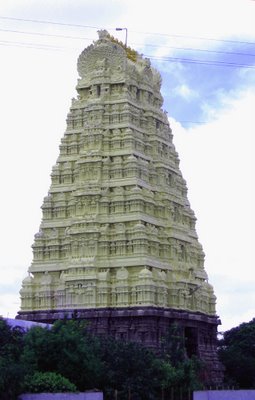
When Mo and I came to Kanchipuram we knew all of these stories, and we felt the excitement growing as we saw the gopurams of the great temples rising above the plains and forests, visible from miles away. We then drove into a Kanchipuram that was only a shadow of its former glory. It is now a town of dusty streets, crowded and polluted, clogged with the refuse of a thousand pilgrims who venerate the temples and pollute the city that houses them. Around each temple are touts and salesmen who harass and chase anyone who wishes to go into the silence to the temple. So aggressive are these con artists that one pried open the door to my car and tried to shove shoes onto my feat, climbing into the seat beside me and screaming the whole time. I had to physically remove him from the car, and came as close to violence as I have in India. The story of Jesus and the money-changers suddenly gained new relevance to me as I watched aggressive, bullying men browbeat humble pilgrims into purchasing wares that they could not afford just so that they could be left in peace to worship.
Inside the temples themselves the scene was different, quieter and calmer. There were till touts, however, temple priests who would press their services on you, drag you from point to point and give broken, incomprehensible descriptions of myths and gods they only half understood, and then demand thousands of rupees in payment. However, unlike the touts outside, these priests would take no for an answer once you grew wise to their ways, and with only ten to twenty minutes of arguing and ignoring their increasingly frantic pleas, you could be left in peace to enjoy the holy ground.
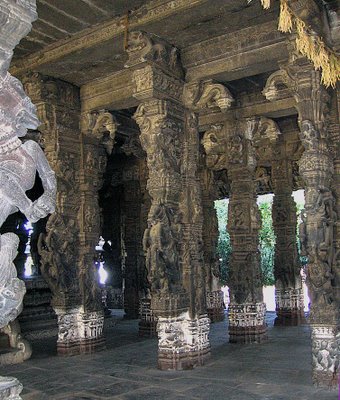
The inside of the temples of Kanchipuram do not disappoint. They are ancient, they are massive, every part of them is carved with images of gods and demons, an unfolding stone mandala of myth and ritual through which the light of sacred fire and the thunder of sacred drums recalls to mind that the worship here has continued unabated for 1400 years. The echoes we heard through the stone forests were heard by Kalidasa and Hsuan Tsang, by emperors and viceroys and sultans, and perhaps even by gods themselves. Golden and soaring, massive and crumbling, the temples are a wonder of the world.
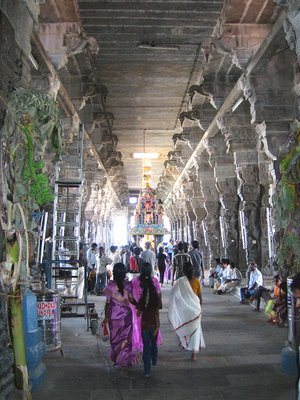
After seeing the temples Mo and I went for lunch. We had our driver, a local boy, take us to a little place – out of the way, down a back ally, used only by the locals. It was an adventure to make our way through the dark ally and up the narrow stairs to a place where tourists never come. We sat down with gusto to a wonderful South Indian meal and half way through noticed that the place mats proclaimed the restaurant had just become a chain. It has a branch in Toronto. We came a very long way to find a restaurant we could have eaten in at home. No matter where you go, there you are.
After lunch Mo went silk shopping. Kanchi, you see, is famous not just for its temples but also for its saris, which are made of the best silk in all of India and hand woven with silver and gold borders. We went into a home loom and saw a sari being woven in the traditional manner, unchanged in hundreds of years, and then were bombarded with saris to buy. We saw wedding saris that were made with over 20 pounds of gold, embroidered into patterns that would leave the mind reeling and unable to follow their grand geometric design. We saw saris like those that princesses and movie stars buy for their formal occasions, and we saw saris that every little girl in India dreams of being able to grow up to own. Mo bought two of them after a haggling session that lasted over an hour and a half, and got such a good price that I couldn't even fault her for making the single largest expenditure of money we made in India.
Aside from the touts the people of Kanchipuram were amazing. We saw the rich in their gorgeous silks and the poor in their rough homespun standing side by side and looking with wonder and devotion at what their ancestors had wrought in the name of their gods.
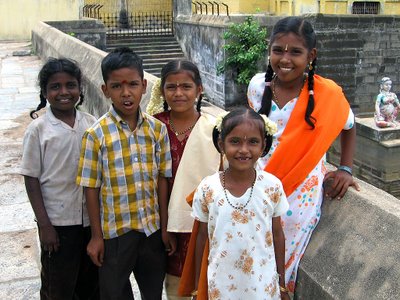
But beyond the pilgrims and the gawkers, we met the others – the folks who make India like no other country. One of these was a new friend of mine, a local art teacher who was very interested in both how I taught my students in America, and how I managed to be a "fatty." He, you see, very much wanted to be a fatty, but couldn't gain weight no matter how he tried. He told me that he would never be considered an accomplished man unless he could become a fatty, and so begged me for my secrets.
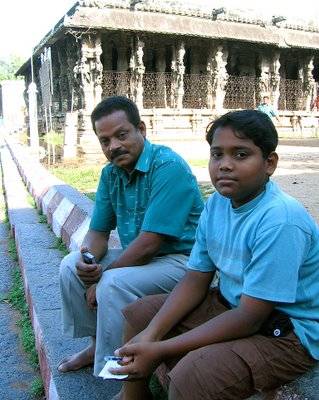
The person that struck us most in the heart, however, was a little girl who we met at a Vishnu temple. We weren't sure if her parents were inside and she had been left to wander, but from what we could gather from hand signs and body language it seemed she was an orphan who lived under the care of the temple. Her face was beautiful, haunting and distantly sad. She drifted like a ghost behind us, avoiding all attempts to photograph her or to get close enough to actually talk. (In the end we only got a photo of her by accident, Mo hit the shutter while cleaning the camera.) For hours she followed us, not begging for or accepting a thing from us other than our presence. In the end she followed us from the temple and stood by our car as the touts pounded on our windows and screamed. In the midst of it all Mo and I looked through the touts and met her eyes, and she smiled sudden and startled. She could not believe that in the midst of all the sound and fury, in the shadow of the storied and mythic gopurams it was her that we chose to look at. No one had ever chosen to see her, and her alone, in her entire life and that realization left us broken hearted as we left Kanchipuram.
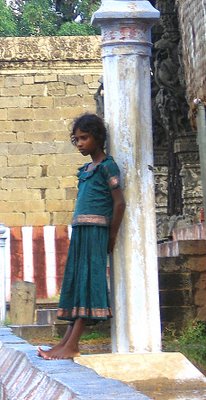
Once it was a great city, now it is a ramble of mythic temples filled with orphans who find it hard to believe that anyone would chose to look at them.
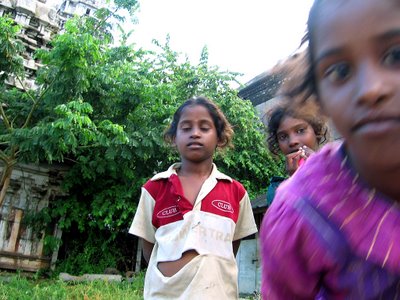
Not long after Bodhidharma's time the Buddhists rulers fell to the great Hindu temple builders of the Pallava dynasty, the same kings who built the monuments of Mamallapuram. What they started with the shore temple they finished here, bringing temple architecture to a zenith that would forever define the Dravidian style of temples. The Cholas would add refinements, certainly, but it was here that the glory of the soaring gopurams and reflective tanks reached their finalized form – a form that lasts to this day, almost 1200 years later.
It was in these great temples that the Brahmins received, recalled, or rehallowed the great center of Kanchipuram: the mango tree under which Lord Shiva was married. This spot is now one of the holiest in all Hinduism, a spot where the divine touched the world and a god married a goddess, sealed forever in an act that guaranteed the continuation of the universe. Even to this day you can see the mango tree where they were married, a marvel of nature that gives mangoes of four different flavors, one for each of the Vedas.
Once upon a time all of the great Tamil dynasties built their temples here, trying to outdo the Pallavas. The Cholas and the Pandyas, in turns, would build temples to rival that of the Mango Tree. They built to Shiva and to Vishnu, making Kanchi one of the few places in India equally holy to the two great gods, a place where rival sects both come for their holiest of pilgrimages. It was during this time that the great traveler Hsuan Tsang cam to Kanchi and commented on how pious and brave where its people, how great its universities and centers of learning. The temple city was even spoken of with love by Kalidasa, the Shakespeare of India, as the Jasmine City, sweetest of all cities of India.
Even into modern times Kanchipuram was vastly important. Robert Clive, in his drive to dominate India, appeased local sensibilities by giving a fabulous necklace to the great Vishnu temple. To this day it is said that the god is dressed in that necklace for holy days and great processions, a sign of the truce between Clive and the holy city.
When Mo and I came to Kanchipuram we knew all of these stories, and we felt the excitement growing as we saw the gopurams of the great temples rising above the plains and forests, visible from miles away. We then drove into a Kanchipuram that was only a shadow of its former glory. It is now a town of dusty streets, crowded and polluted, clogged with the refuse of a thousand pilgrims who venerate the temples and pollute the city that houses them. Around each temple are touts and salesmen who harass and chase anyone who wishes to go into the silence to the temple. So aggressive are these con artists that one pried open the door to my car and tried to shove shoes onto my feat, climbing into the seat beside me and screaming the whole time. I had to physically remove him from the car, and came as close to violence as I have in India. The story of Jesus and the money-changers suddenly gained new relevance to me as I watched aggressive, bullying men browbeat humble pilgrims into purchasing wares that they could not afford just so that they could be left in peace to worship.
Inside the temples themselves the scene was different, quieter and calmer. There were till touts, however, temple priests who would press their services on you, drag you from point to point and give broken, incomprehensible descriptions of myths and gods they only half understood, and then demand thousands of rupees in payment. However, unlike the touts outside, these priests would take no for an answer once you grew wise to their ways, and with only ten to twenty minutes of arguing and ignoring their increasingly frantic pleas, you could be left in peace to enjoy the holy ground.
The inside of the temples of Kanchipuram do not disappoint. They are ancient, they are massive, every part of them is carved with images of gods and demons, an unfolding stone mandala of myth and ritual through which the light of sacred fire and the thunder of sacred drums recalls to mind that the worship here has continued unabated for 1400 years. The echoes we heard through the stone forests were heard by Kalidasa and Hsuan Tsang, by emperors and viceroys and sultans, and perhaps even by gods themselves. Golden and soaring, massive and crumbling, the temples are a wonder of the world.
After seeing the temples Mo and I went for lunch. We had our driver, a local boy, take us to a little place – out of the way, down a back ally, used only by the locals. It was an adventure to make our way through the dark ally and up the narrow stairs to a place where tourists never come. We sat down with gusto to a wonderful South Indian meal and half way through noticed that the place mats proclaimed the restaurant had just become a chain. It has a branch in Toronto. We came a very long way to find a restaurant we could have eaten in at home. No matter where you go, there you are.
After lunch Mo went silk shopping. Kanchi, you see, is famous not just for its temples but also for its saris, which are made of the best silk in all of India and hand woven with silver and gold borders. We went into a home loom and saw a sari being woven in the traditional manner, unchanged in hundreds of years, and then were bombarded with saris to buy. We saw wedding saris that were made with over 20 pounds of gold, embroidered into patterns that would leave the mind reeling and unable to follow their grand geometric design. We saw saris like those that princesses and movie stars buy for their formal occasions, and we saw saris that every little girl in India dreams of being able to grow up to own. Mo bought two of them after a haggling session that lasted over an hour and a half, and got such a good price that I couldn't even fault her for making the single largest expenditure of money we made in India.
Aside from the touts the people of Kanchipuram were amazing. We saw the rich in their gorgeous silks and the poor in their rough homespun standing side by side and looking with wonder and devotion at what their ancestors had wrought in the name of their gods.
But beyond the pilgrims and the gawkers, we met the others – the folks who make India like no other country. One of these was a new friend of mine, a local art teacher who was very interested in both how I taught my students in America, and how I managed to be a "fatty." He, you see, very much wanted to be a fatty, but couldn't gain weight no matter how he tried. He told me that he would never be considered an accomplished man unless he could become a fatty, and so begged me for my secrets.
The person that struck us most in the heart, however, was a little girl who we met at a Vishnu temple. We weren't sure if her parents were inside and she had been left to wander, but from what we could gather from hand signs and body language it seemed she was an orphan who lived under the care of the temple. Her face was beautiful, haunting and distantly sad. She drifted like a ghost behind us, avoiding all attempts to photograph her or to get close enough to actually talk. (In the end we only got a photo of her by accident, Mo hit the shutter while cleaning the camera.) For hours she followed us, not begging for or accepting a thing from us other than our presence. In the end she followed us from the temple and stood by our car as the touts pounded on our windows and screamed. In the midst of it all Mo and I looked through the touts and met her eyes, and she smiled sudden and startled. She could not believe that in the midst of all the sound and fury, in the shadow of the storied and mythic gopurams it was her that we chose to look at. No one had ever chosen to see her, and her alone, in her entire life and that realization left us broken hearted as we left Kanchipuram.
Once it was a great city, now it is a ramble of mythic temples filled with orphans who find it hard to believe that anyone would chose to look at them.



1 Comments:
In less than one heartbeat, if it is true that she has no one to call her own, I would hold out my hand and become that child's mother.
Post a Comment
<< Home